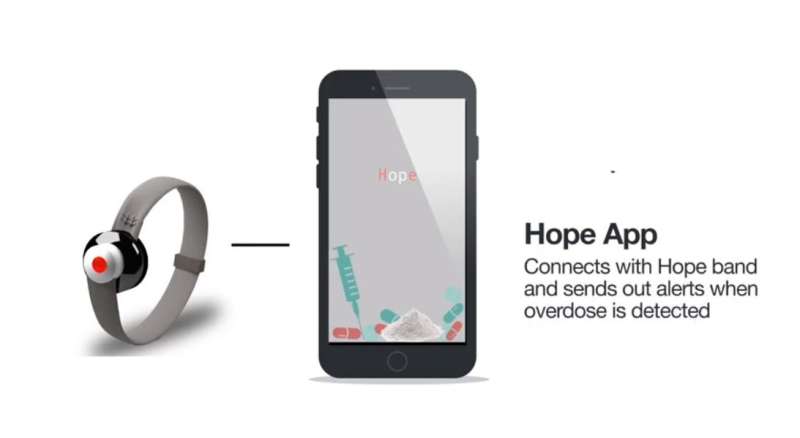December 31, 2018 weblog
Students develop band device for opioid overdose alerts

Anyone familiar with statistics and headlines about opioid addiction was not shocked to see that in the United States by late 2017 opioid addiction was declared a national public health emergency.
Now a team of Carnegie Mellon software engineering students have built a wristband that can detect an opiate overdose and send out alerts and a message so that contacts can intervene. The students are calling it the HopeBand and, in the context of an opiate overdose when time for intervention can impact survival, it is a tool of hope.
This was actually a project for the Institute for Software Research's professional master's program in embedded software engineering (MSIT-ESE). A pharmaceutical consulting firm sponsored the project, Pinney Associates.
HopeBand is described as a wrist-mounted "pulse oximetry" device. Yu-Sam Huang, Carnegie Mellon, said you just pair the band with your smartphone so if it picks up an overdose, it will alert emergency contacts.
Jeremy Hsu in IEEE Spectrum discussed how it works to pick up the signs of distress. Hsu said that pulse oximetry sensors "can monitor the oxygen levels in blood by shining light from LEDs through the skin and detecting changes in light absorption. If oxygen levels drop low enough to signal possible overdose, the device monitors the situation for 10 seconds before sounding the alarm."
The Carnegie Mellon ISR site talked about the process.
"When paired to a mobile phone via Bluetooth, the sensor takes numerous readings on an ongoing basis to establish a baseline reading. If the user's blood oxygen level drops for more 30 seconds, the device switches an LED on the display from green to red. The device also cues the paired mobile phone—via an app the team also developed—to send out a message with the user's GPS coordinates to his or her emergency contacts."
PCMag said, "That way, a life-saving dose of naloxone, a medication that can reverse an opioid overdose, can, hopefully, be administered in time."
Nonetheless, the life-saving factor would not be just naloxone nearby the victim but having somebody nearby who can administer it. "Having naloxone on hand doesn't matter if you overdose and there is nobody nearby to administer it," said Michael Hufford, CEO of Harm Reduction Therapeutics.
Students designed the band, after all, with a key goal "to minimise the time required before health professionals can administer drugs to reverse an overdose," said Joseph Archer in The Telegraph. The team recognized there was a narrow window of time for providing medical assistance. Another goal was to come up with something that would be low-cost.
In the Institute for Software Research Carnegie Mellon article, Pinney senior data manager Steve Pype, said, "Initially, we were thinking this might be a proof of concept. But here we are: The project is almost finished and they're refining the prototype."
What's next?
Back in August, Soham Donwalkar said their next step was to develop machine learning algorithms to improve the prediction accuracy.
In the Carnegie Mellon article, he said there were ways the product could be even better. "I can absolutely see additional sensors being incorporated to give a machine-learning backend a bigger dataset to work with, reducing the number of false positives, for example. Or, once clinical trials are open, assembling a much larger, more diverse corpus for ML training that encompasses a wide range of physical variables—like age, sex, race, etc.—that could affect what an overdose state looks like!"
"The team plans to start offering it for free via needle exchange programs," said PCMag. "They eventually aim to sell it for between $16 and $20 and add features that can help wearers fight their addiction."
Jeremy Hsu in IEEE Spectrum said the band is one of other efforts investigating "how devices similar to wristbands or watches could track certain health measures that may indicate an opioid overdose." The public health crisis has spurred a number of companies and universities to develop solutions, he said.
More information: www.isri.cmu.edu/news/2018/2018113-hashtag.html
© 2018 Science X Network


















